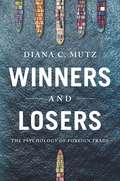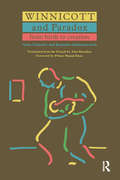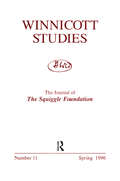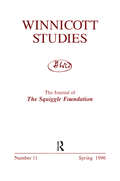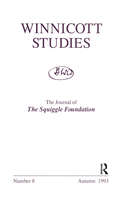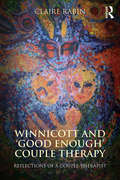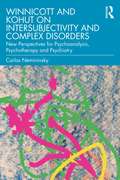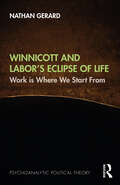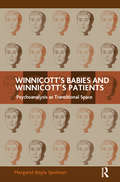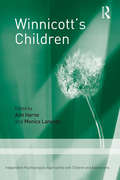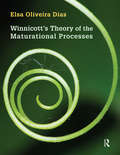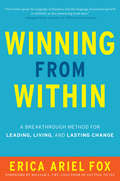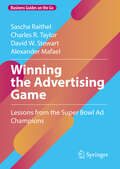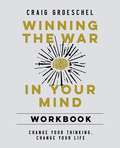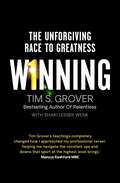- Table View
- List View
Winners and Losers: The Psychology of Foreign Trade (Princeton Studies in Political Behavior #27)
by Diana C. MutzFrom acclaimed political scientist Diana Mutz, a revealing look at why people's attitudes on trade differ from their own self-interestWinners and Losers challenges conventional wisdom about how American citizens form opinions on international trade. While dominant explanations in economics emphasize personal self-interest—and whether individuals gain or lose financially as a result of trade—this book takes a psychological approach, demonstrating how people view the complex world of international trade through the lens of interpersonal relations.Drawing on psychological theories of preference formation as well as original surveys and experiments, Diana Mutz finds that in contrast to the economic view of trade as cooperation for mutual benefit, many Americans view trade as a competition between the United States and other countries—a contest of us versus them. These people favor trade as long as they see Americans as the "winners" in these interactions, viewing trade as a way to establish dominance over foreign competitors. For others, trade is a means of maintaining more peaceful relations between countries. Just as individuals may exchange gifts to cement relationships, international trade is a tie that binds nations together in trust and cooperation.Winners and Losers reveals how people's orientations toward in-groups and out-groups play a central role in influencing how they think about trade with foreign countries, and shows how a better understanding of the psychological underpinnings of public opinion can lead to lasting economic and societal benefits.
Winnicott Paradox: From birth to creation
by Anne Clancier Jeannine KalmanovitchWinnicott stressed the importance and the peculiarity of paradox in human development, as well as the necessity of supporting and accepting it. As Masud Khan points out in his foreword to the book, Winnicott emphasized the many ways in which paradox formed a part of his own life, from the very beginning; and we find its application throughout his work, both in his practice and in the way he expresses his theoretical thoughts. The book begins with a preface by Simone Decobert, who very vividly describes the first impact of Winnicott's striking personality on her. In her preface, Dr Decobert speaks about the preconceived ideas circulating in Paris about Winnicott's work, and the way he explained, almost defended, his ideas in the early sixties. She examines some of the criticism levelled at the introduction of the parameter of external reality in treatment, the notion of 'holding', as well as the question concerning the variations in technique.
Winnicott Studies
by Laurence SpurlingThe Squiggle Foundation's aims are to study and disseminate the work of Winnicott, with a particular emphasis on application.
Winnicott Studies
by Laurence Spurling Squiggle FoundationThe Squiggle Foundation's aims are to study and disseminate the work of Winnicott, with a particular emphasis on application.
Winnicott Studies. No 8
by Laurence Spurling Squiggle FoundationThe Squiggle Foundation's aims are to study and disseminate the work of Winnicott, with a particular emphasis on application.
Winnicott and 'Good Enough' Couple Therapy: Reflections of a couple therapist
by Claire RabinClaire Rabin innovatively applies the Winnicottian theory of the ‘good enough mother’ to couple therapy, redirecting attention to the therapeutic relationship and the therapist’s self-awareness regardless of the methods used. Using this lens, even the therapist’s mistakes become an opportunity for repairing both the therapeutic relationship and the partners’ own personal maturity. The intensity and pressure of couple therapy can make each case a test of the therapist’s competence. The need for neutrality constitutes on-going pressure on the therapist and the proliferation of therapeutic methods can cause confusion about which might be most useful in each situation. Applying theory effectively is easier said than done within the context of the powerful emotions unleashed in sessions, which can result in a catastrophic atmosphere. These factors can make it hard for therapists to utilise their own skills and knowledge within sessions of couple therapy. The book explores how therapists and couples can unintentionally further ‘false selves’ without realising how the very tools of change may counter authenticity. Featuring interviews with an international range of couple therapists and case studies from the author’s own experiences, the key aspects of the ‘good enough’ concept are elaborated. Rabin shows how these ideas can strengthen therapists’ sense of security and safety in using their lived experience and intuition. Winnicott and Good Enough Couple Therapy is the ideal book for clinicians seeking an overarching framework for working with couples or families, as well as those concerned with the importance of the client-helper relationship.
Winnicott and Kohut on Intersubjectivity and Complex Disorders: New Perspectives for Psychoanalysis, Psychotherapy and Psychiatry
by Carlos NemirovskyGiven the complexity of scientific developments inside and outside the psychoanalytic field, traditional definitions of basic psychoanalytic notions are no longer sufficiently comprehensive. We need conceptualizations that encompass new clinical phenomena observed in present-day patients and that take into account contributions inside, outside, and on the boundaries of our practice. This book discusses theoretical concepts which explain current clinical expressions that are as ineffable as they are commonplace. Our patients resort to these expressions when they feel distressed by their perception of themselves as unreal, empty, fragile, non-existent, non-desiring, doubtful about their identity, beset by feelings of futility and apathy, and emotionally numb. The book aims at contrasting the ideas of Winnicott and Kohut, which are connected with a clinical practice that sees each patient as unique and are moreover in direct contact with empirical facts, and applies them to the benefit of complex patients. These ideas facilitate the expansion of paths in both the theory and the practice of our profession. Uniquely contrasting the works of two seminal thinkers with a Latin American perspective, Winnicott and Kohut on Intersubjectivity and Complex Disorders will be invaluable to clinicians and psychoanalysts.
Winnicott and Labor’s Eclipse of Life: Work is Where We Start From (Psychoanalytic Political Theory)
by Nathan GerardNathan Gerard draws upon the pathbreaking insights of a pediatrician and psychoanalyst D. W. Winnicott to offer a new set of ideas in the novel domain of contemporary work life and its discontents. Locating Winnicott within a broad landscape of critical scholarship that dissects work’s perils, the book positions Winnicott as both a radical critic and creative advocate for building a different kind of work life—one that might make room for the presence of self. By shuffling the discourse on neoliberal subjectivity to reclaim what Winnicott calls “unit status” of the separate self, Gerard differentiates Winnicott from the relational tradition by advocating for Winnicott’s non-relational aspects. Through such analysis, the book reveals how work and home have become two sides of the same impoverished coin, each contributing to a legitimately “bad environment” that perpetuates self-absence and annihilates one’s unique sense of “feeling real” and alive. Winnicott and Labor’s Eclipse of Life will be of interest to readers of Winnicott and psychoanalysis, organization and management studies, and anyone hoping to deepen their engagement with the dynamics of contemporary work life.
Winnicott and the Psychoanalytic Tradition: Interpretation and Other Psychoanalytic Issues (The\winnicott Studies Monograph Ser.)
by Lesley CaldwellThis book focuses on two themes: the first theme is the true self and the resonance of Winnicott's thinking with the contributions of other major psychoanalysts of the past half century; the second theme emerges from the first: the pursuit of authenticity, whether by patient or analyst.
Winnicott on the Child
by Stanley I. Greenspan Benjamin Spock T. Berry Brazelton D. W. WinnicottThis delightful book presents a selection of D. W. Winnicott's best writing about children. The remarkable, enduring essays from Babies and Their Mothers and Talking to Parents are here combined with several hard-to-find gems of insight into the world of the child. Each piece was written for a wide audience of parents, childcare professionals, and teachers. In his empathic and witty way, Winnicott ranges over such timeless topics as the mother/infant relationship, trust, instilling a sense of security, negativism, jealousy and moral development. Now, in one volume, anyone who cares about children can enjoy the wisdom of a man many consider to be the most important psychoanalyst since Freud. A Merloyd Lawrence Book
Winnicott's Babies and Winnicott's Patients: Psychoanalysis as Transitional Space
by Margaret Boyle SpelmanWinnicott's thinking continues to grow in importance in psychoanalysis today. This book can be described as a clinical primer: by presenting her own personal responses to Winnicott and her initial understanding of his thinking, the author tries to help others develop their own 'Winnicott' to assist with their clinical thinking. This book makes explicit the parallel in Winnicott's thinking between the situation of the baby and the 'nursing couple', and the patient and the 'analytic couple'. There are two helpful baby observation pieces which are aimed at first giving something of the experience of completing a baby observation and then of the reporting of it. In addition to these, there are chapters that treat Winnicott's thinking and the comparison of the original baby with the one who appears in the course of an adult therapy. Winnicott's thinking is first situated historically. Then each of his three stages of dependence are explored in detail: absolute dependence, relative dependence, and going towards independence. These are looked at from the viewpoint of the patient/baby and the mother/therapist in both developmental and clinical situations.
Winnicott's Children: Independent Psychoanalytic Approaches With Children and Adolescents
by Ann Horne Monica LanyadoWinnicott’s Children focuses on the use we make of the thinking and writing of DW Winnicott; how this has enhanced our understanding of children and the settings where we work, and how it has influenced the way in which we do that work. It is a volume by clinicians, concerned about how, as well as why, we engage with particular children in particular ways. The book begins with a scholarly and accessible exposition of the place of Winnicott in his time, in relation to his contemporaries – Melanie Klein, Anna Freud, John Bowlby – and the development of his thinking. The dual focus on the earliest experience of the infant and its consequences plus the ‘how’ of engaging with children – as good-enough mothers or good enough therapists – is picked up in the chapters that follow. The role of play is central to a chapter on supervision; struggling through the doldrums can be part of the adolescent’s experience and that of those who engage with him; the role of psychotherapy in a Winnicottian therapeutic community and an inner city secondary school is explored; and a chapter on radio work links us personally with Winnicott and his desire to talk plainly and helpfully to parents. There is a richness in the collection of subjects in this book, and in the experience of the writers. It will appeal to those who work with children – in child and family mental health settings, schools, hospitals, colleges and social care settings.
Winnicott's Theory of the Maturational Processes
by Elsa Oliveira DiasThis book presents the central concepts of Winnicott's theory of the maturational processes, clarifying its premises and providing an organised description of the various stages, with their respective tasks and achievements. This theory, considered by Winnicott as the backbone of his theoretical and clinical work, can be used as a practical guide for the understanding of health phenomena and for the early detection of emotional difficulties. It also provides the framework from which different aspects of the study of human nature can be developed, such as those related to cultural achievements and the entire domain of creativity, as well as the basis on which it is possible to clarify concepts about psychic disorders, on account of their intimate connection with the stages of maturation. Just as Winnicott did, this study will concentrate on the early stages, when the foundation of personality and psychic health is established.
Winnicott’s Letter to Bion: Playing, Dreaming, and Beyond (The International Psychoanalytical Association International Psychoanalysis Library)
by Steven H. Cooper Christopher G. LovettWinnicott’s Letter to Bion presents reflections on a fascinating moment in the history of psychoanalytic thinking.Donald Winnicott’s letter, sent on October 5, 1967, and conveying thoughts about two of Wilfred Bion’s papers, never received a response. In this book, international contributors elaborate on the contents of the letter, overlapping and divergent projects of the two psychoanalysts, and the meaning of Bion’s silence. The chapters consider topics including the historical context of their work, their focuses on play and reverie, and the question of the sensuous.Winnicott’s Letter to Bion will be of great interest to psychoanalysts in practice and in training, and to historians of psychoanalysis.
Winning Fights: 12 Proven Principles for Winning on the Street, in the Ring, at Life
by Dr Phillip StephensWinning Fights focuses on 2,500 years of proven fighting principles originating from Eastern concepts and proceeding to the modern era. This book is for pugilists seeking an edge in competition as well as soldiers and law enforcement officers facing conflict. Like The Art of War and The Book of Five Rings, however, many of its lessons also apply to the world of business and negotiation. The majority of martial art books are dedicated to technique. They feature photos and descriptions of strikes, blocks, evasions, and submissions. While many of these titles are important and influential, it is clear that if our martial study is simply about acquiring new tactics, we risk leaving a void in our training—and possibly in our own character. Dr. Phillip Stephens conducted extensive research in developing this work. He drew from his years of martial training and his experience as a member of the North Carolina Boxing Commission. He even reached out to combat personnel at Fort Bragg, North Carolina, who offered additional insight on what it takes to prepare for combat—and to prevail. Dr. Stephens looked beyond the technical to the conceptual and found that winning fights requires twelve core principles: preparation, awareness, commitment, lethality, efficiency, discipline, power, focus, fierceness, surprise, timing, and fortitude. This book features • Twelve principles for winning fights • A survey of Eastern and Western traditions • An intelligent yet accessible discussion of these concepts With this book you will • Learn to see beyond fighting tactics, which change, to fighting principles, which endure • See your training in powerful new ways “Winning fights is based on principles, not techniques,” Dr. Stephens writes. “Technique is important, but techniques change, adapt, and evolve. Principles are timeless.”
Winning Habits: How Elite Equestrians Master the Mental Game
by Annette PaterakisA unique and groundbreaking analysis of how to succeed in equestrian sport, this book unpacks the winning habits of successful equestrians to form a toolkit for readers to develop their own winning habits. Applying psychological understanding in peak performance, this book is bolstered by interviews with top contemporary professional show jumping athletes to explore and show how leading equestrians have interpreted various methods and built them into approaches for their own training. Theoretical concepts such as mindset, deliberate practice, focus and flow are broken down and translated into practical steps for a more powerful and effective way of thinking, training and performing. Renowned equestrian mental coach Annette Paterakis reveals factors of success, as well as answers common questions, from building lasting confidence to responding to failure. Smashing the myths of talent and hard work, Paterakis offers a refreshing take on mindset, focus and approach to success both in and out of the show ring. An essential read for anyone who would like to learn about or improve their mental game, this book is uniquely suited for equestrian riders, coaches and other athletes, as well as offering supplementary reading for applied sport psychology courses.
Winning Points with the Woman in Your Life One Touchdown at a Time
by Jaci RaeWINNING POINTS WITH THE WOMAN IN YOUR LIFE ONE TOUCHDOWN AT A TIME GIVES THE MAN WHO WANTS TO BE A STAR QUARTERBACK IN LOVE "GAME PLANS"...EXPLAINED IN FOOTBALL TERMINOLOGY. As the new star quarterback steps into the stadium for the first time, his body and mind fill with anticipation and apprehension for what lies ahead in the coming season. Will he run or pass? How will he win the most games with the fewest fumbles and penalties so that he's the one on the field come Super Bowl Sunday? The answer boils down to what he's learned from watching, practicing -- and reading the playbook. The same applies to relationships. For would-be Romeos of all ages who ask, "How do I win in the game of love?" comes a relationship playbook. While mistakes happen in any game -- and any relationship -- many can be prevented by learning the right set of moves and using the correct language that will get you off the bench, in the game, and eventually into the end zone. Using football terminology to reveal the mysteries of women (like what they look for in men) and the best ways to approach, charm, and date them, Winning Points with the Woman in Your Life One Touchdown at a Time explains: Communication that will help you avoid incomplete passes every time Why hitch and go doesn't work in relationships (do what you say) Recruiting and stats: things women need you to know How to gain the same trust, honor, and respect from a woman that players on a team have for each other The last pass: how and where to meet the woman in your life And much, much more. Peppered with relationship advice from legendary NFL players as well as from Scripture, Winning Points with the Woman in Your Life One Touchdown at a Time enables you to peer inside the female mind and heart so that you can find yourself in a great relationship -- without lost yardage.
Winning Ways For Early Childhood Professionals: Understanding Toddlers and Twos
by Gigi SchweikertUnderstand the complex—yet amazing—toddler years as you help children develop new skills <p><p> One- and two-year-olds are in the midst of developing and exploring their skills to communicate, move purposely, and assert their independence and individuality. As their teacher, you have great patience, energy, and creativity as you work with their “on the go” approach to life. <p><p>Use this professional development workbook to help navigate the complex toddler years and gain a better understanding of their growth and development. You will improve your interactions with them by responding to their individual needs, find out how to create a routine and environment that keeps toddlers safe as they explore and learn, and assist them as they develop self-help skills such as toileting, dressing, and eating. <p><p>This is a great educational and training tool whether you are a veteran educator, new teacher, college student, or career seeker. You’ll learn fascinating facts, and you’ll be reminded of how important your job as an early childhood professional truly is.
Winning Ways for Early Childhood Professionals Understanding Infants
by Gigi SchweikertAs an early childhood professional who works with infants, you provide the care and nurturing they need to grow and flourish. You make a difference in their first year--one that is filled with remarkable growth. Being an infant teacher requires knowing and understanding infants, observing them closely, and responding appropriately to their subtle and not-so-subtle cues. Use this professional development workbook to gain insight into the amazing capabilities of infants, learn about their development, create a more infant-appropriate routine and program, and provide them with security, comfort, and stability as they explore and learn with confidence. This is a great educational and training tool whether you are a veteran educator, new teacher, college student, or career seeker. You'll learn fascinating facts, and you'll be reminded of how important your job as an early childhood professional truly is.
Winning Ways for Early Childhood Professionals: Understanding Preschoolers
by Gigi SchweikertWinning Ways For Early Childhood Professionals
Winning from Within
by Erica Ariel FoxLife is a series of negotiations, whether or not you think of yourself as a negotiator . From seemingly insignificant daily decisions to major life choices, you negotiate every time you aim to persuade, argue over a decision, or resolve a conflict. But as negotiations and leadership expert Erica Ariel Fox reveals, the most important negotiations--the ones that determine the impact of our actions and the quality of our lives--are those we have with ourselves. Most of us recognize the difference between our knowledge--what we know we should do and say--and our knowhow--what we actually do and say in real life when it counts. Fox calls this the "Performance Gap," and she shows you how to close it, turning breakdowns into breakthroughs, whether struggling with a difficult client, arguing with a combative teenager, or organizing for community action. Winning from Within combines insights from Western psychology and Eastern philosophy with practical applications from real business situations and everyday life. Fox shows that the ability to achieve mastery over how we interact with each other comes from within, from the "center" where desires, thoughts, feelings, and impulses to take action live side-by-side. Winning from Within offers a profound and highly practical seven-step method for making changes that last--at work and at home.
Winning the Advertising Game: Lessons from the Super Bowl Ad Champions (Business Guides on the Go)
by Sascha Raithel Charles R. Taylor David W. Stewart Alexander MafaelUnlock the secrets of advertising success with this comprehensive guide! Dive into practical insights and real-world data to enhance your campaigns. Explore the Super Bowl as a live advertising lab, dissecting branding strategies, creative elements, and societal impacts. Learn from advertisers, agencies, and experts, and apply these lessons to your own efforts. Perfect for marketing managers, advertisers, and educators looking to leverage the biggest advertising event in the world. This book provides actionable research findings and tools to transform your advertising approach, ensuring your ads stand out and resonate with audiences. Discover how the NFL and Super Bowl are expanding globally, reaching new audiences worldwide. This book is ideal for marketing managers and advertisers seeking to apply key lessons from the Super Bowl to their campaigns. It’s also a valuable resource for marketing and advertising educators who want to illustrate fundamental principles with real-world examples.
Winning the War in Your Mind Workbook: Change Your Thinking, Change Your Life
by Craig GroeschelIn this twelve-lesson workbook, pastor and New York Times bestselling author Craig Groeschel pairs modern psychology and biblical teaching to reveal how to win the war in your mind and restore daily peace in your life. What you think shapes who you are.If your thoughts are out of control, your life will be as well. Both the Bible and modern science provide evidence that this is true.In recent years, a discipline of psychology called cognitive behavioral therapy has gained popularity. This discipline is rooted in an understanding that many problems--from eating disorders to relational challenges, addictions, and even some forms of depression--are rooted in negative patterns of thinking. Treating those problems begins with changing that thinking.This has many parallels with Scripture. In Paul's letter to the Philippians, he writes about turning our thoughts to certain types of things (truth, purity, loveliness...) and putting them into practice so that we experience God's peace.In this workbook, Craig goes deeper into the principles outlined in his book (sold separately) to reveal the strategies he has discovered that will change your mind and, by extension, your life for the long-term. Each lesson includes biblical exploration, reflection and application questions, and practical exercises to help you:Gain insight into how your brain works and how your thoughts affect your reality.Identify your destructive thought patterns and eliminate them from your life.Become a thought warrior and replace the enemy's lies with God's truth.God has something better for your life than your old ways of thinking. It's time to change your mind so God can change your life.
Winning: Reflections on an American Obsession
by Francesco DuinaWhy winning doesn’t always lead to happinessMost of us are taught from a young age to be winners and avoid being losers. But what does it mean to win or lose? And why do we care so much? Does winning make us happy? Winning undertakes an unprecedented investigation of winning and losing in American society, what we are really after as we struggle to win, our collective beliefs about winners and losers, and much more.Francesco Duina argues that victory and loss are not endpoints or final destinations but gateways to something of immense importance to us: the affirmation of our place in the world. But Duina also shows that competition is unlikely to provide us with the answers we need. Winning and losing are artificial and logically flawed concepts that put us at odds with the world around us and, ultimately, ourselves. Duina explores the social and psychological effects of the language of competition in American culture.Primarily concerned with our shared obsessions about winning and losing, Winning proposes a new mind-set for how we can pursue our dreams, and, in a more satisfying way, find our proper place in the world.
Winning: The Unforgiving Race to Greatness (Tim Grover Winning Ser.)
by Shari Wenk Tim S. Grover&‘Tim Grover&’s teachings completely changed how I approached my professional career, helping me navigate the constant ups and downs that sport at the highest level brings.&’ Marcus Rashford, MBEFrom the elite performance coach for Michael Jordan, Kobe Bryant, Dwyane Wade and many others - and the author of the powerful bestseller Relentless - a no-holds-barred formula for winning that is ideal for business people, athletes and anybody wanting to achieve success. In Relentless, Tim Grover showed that you need to be tough and ruthless - towards others and yourself - to achieve your goals. Now, in Winning he takes that skill repertoire to an even higher level, demonstrating why he is one of the world&’s most sought-after mindset experts. Based on three decades of work with elite competitors like Michael Jordan, Kobe Bryant and Dwyane Wade, Winning challenges you to destroy every obstacle in your path, even if, at the moment of greatest triumph, it may be all taken away. Whether you&’re an athlete striving to win, an entrepreneur building a business, a CEO managing an empire, a salesperson looking to close a deal, or a high achiever determined to stand in the winner&’s circle, Winning offers thirteen key principles for ramping up your performance to the maximum. If you&’re addicted to the taste of success and crave more, then you&’re ready for the results-driven performance formula found here. And if you&’re already winning and want to learn how to execute excellence repeatedly - so you can own not just this moment, but the next, and the next - then Winning is for you.
